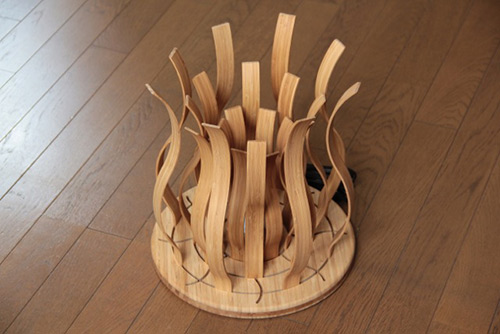Since early in history, bamboo has been a part of Japanese everyday life.
Bamboo, which grows quickly and is environment-friendly, is a natural resource abundant in Japan.
The Japanese take pleasure in eating bamboo shoots, and use bamboo to create tools such as baskets and strainers.
Bamboo is also considered one of the lucky plants in "Sho-chiku-bai ( pine, bamboo, plum) and is honored during various religious festivities.
Our present world is filled with items made of various materials.
Of those materials, Japan's natural bamboo is an ecological resource that can easily be burnt into ash and returned to the soil as enrichment.
Bamboo reaches its fullest height in two to three years and can grow quickly after being trimmed. In comparison to other plants, bamboo has little risk of depletion.


While Japan depends largely on import for food and raw materials, bamboo is in abundance.
Today, bamboo fibers are used in textiles, bamboo is compressed and made into laminated lumber for furniture. In addition, bamboo is widely used as material for paper products or made into coal to serve as a food preservative.
Bamboo can be used with traditionally Japanese materials such as washi paper as well as with glass or leather.
There is no other material that is so closely linked to Japanese everyday life, useful or environment-friendly. Bamboo continues to provide unlimited possibilities.
We have a collection of natural bamboo products from all over Japan that represent each craftperson's devotion and producer's dedication, from everyday items to industrial products.
Bamboo is not the answer to everything, but it can add a little something to each of your lives.
Tomotake Ichikawa, Fifth Generation Owner, Japanese bamboo & natural products store “ICHIKAWA"
ICHIKAWA SHOTEN creates interior products out of bamboo, a natural resource that grows quickly and is abundant in Japan.
Products designs are appealing because of their ability to disguise bamboo for other materials.
Since 1907 during the Meiji Era, ICHIKAWA SHOTEN has continued to provide distinguished bamboo products.
From an ecological standpoint, we would like more consumers to know about Japan's abundant natural resource: bamboo.
We hope our Japanese customers will familiarize themselves with bamboo products while our overseas customers will appreciate the Japanese art of bamboo.
Handling Instructions
- When using bamboo baskets under water, handle quickly, and dry baskets in a well-ventilated place. Try to choose a shady place to dry the products, rather than leaving them directly exposed to the sun. When dried under the sun, products may crack due to excessive drying. Products are not dishwasher-safe.
- When using other bamboo products, avoid getting them wet and towel dry with a soft cloth to clean.
- Avoid storing bamboo baskets in areas with high humidity. Keep them in a well-ventilated, dry place.When products are exposed to rain or water, quickly wipe and dry well. Products should be stored higher off the ground to avoid dampness.
Handling Instructions
Bamboo contains sugar and may attract insects. Prior detecting of insects (Dinoderus MInutus, Maize Weevil) hidden in the bamboo is very difficult. While we take caution, there is a possibility that a white powder may seep out of holes in the bamboo as a result. We avoid using chemical pesticides on our products, and thank you in advance for your understanding.
If a white powder is found seeping out of the small holes in the bamboo, pour hot water (60 degrees celsius or above) on the bamboo.
Preventing Mildew
The best way to maintain bamboo is to use the product every day. Bamboo craftspeople have always created products for daily use. Some bamboo artwork is too precious for daily use, but the products we offer should be used on a regular basis.



